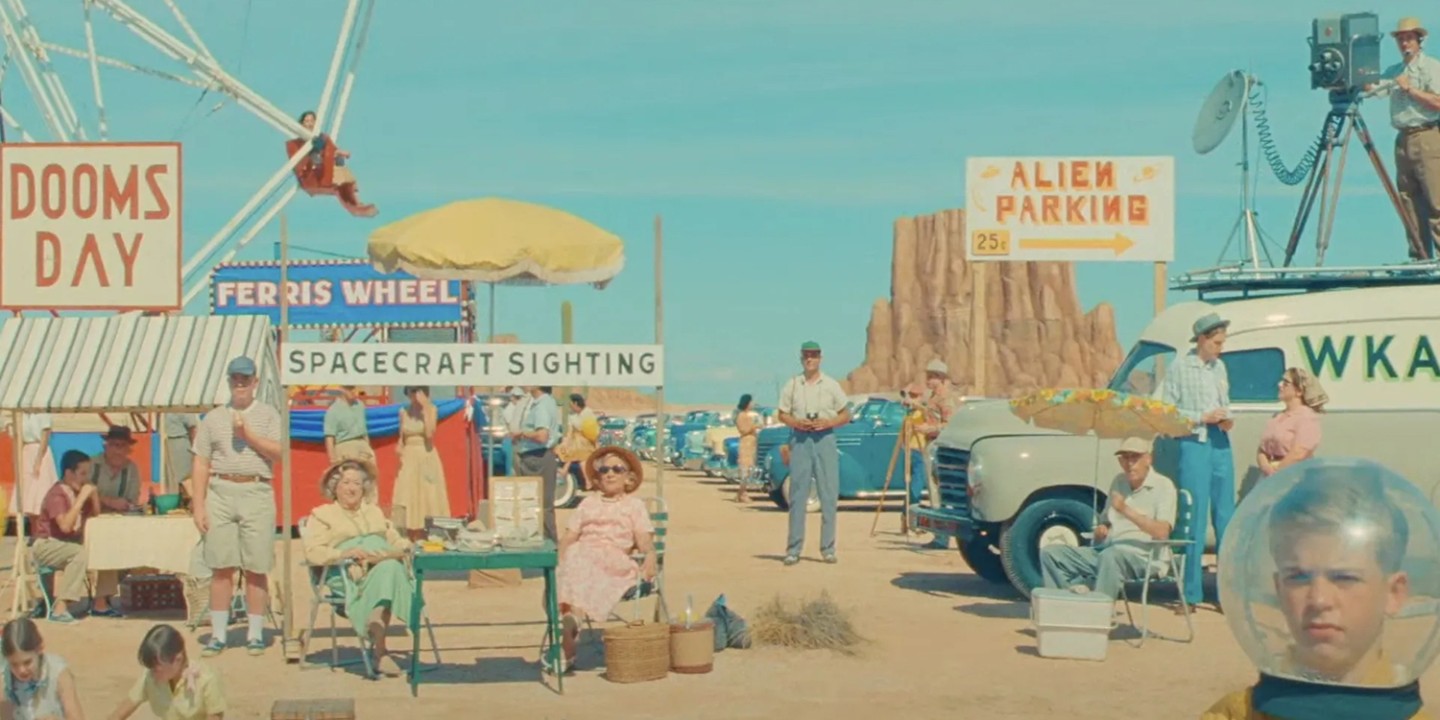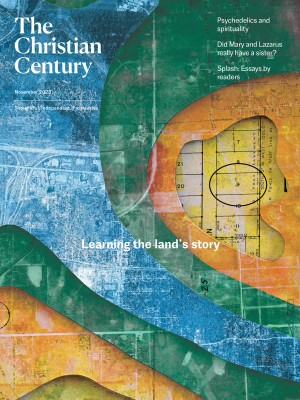All in with Wes Anderson
Asteroid City might be the most Anderson of all his films, and I came to it like an acolyte who is doubting the mystery.

Image courtesy of Focus Features
After more than 20 years, I still exchange lines from Wes Anderson’s first film Bottle Rocket (1996) like a private code with some of my closest friends. My husband and I have taught our children to make the bird cry the main characters use as a signal in their heist schemes (“ca-caw, ca-caw”) so we can find each other in crowded spaces. Every time a first-generation college student ends up in my office, I want to quote them Bill Murray’s chapel speech from Rushmore (1998): “Take dead aim on the rich boys. Get them in the crosshairs and take them down.” When I asked a friend from divinity school to baptize our second child, she sent me back a scene from Moonrise Kingdom (2012) as her affirmative response. In 2014, I wrote a book chapter on the exuberant authenticity of Anderson’s films as an anecdote to modern bureaucratic dread. I have been, at least for periods of my life, all in on Anderson’s films.
Being all in is a good description of Anderson’s filmmaking. His visual style is so recognizable that the phrase “like a Wes Anderson movie” can be used to describe memes, clothing choices, buildings, interior design, or even accidental moments of life when the precise, idiosyncratic, unique, or precious coalesce. By his third movie, The Royal Tenenbaums (2001, perhaps my favorite), his hallmark visual style asserted itself as the most “Anderson-y” thing about his work: highly stylized sets and carefully constructed worlds that draw attention to their own artfulness.
Read our latest issue or browse back issues.
In many of his films, his own carefully crafted style expresses something about the moral commitments of his characters that I find deeply attractive. Resisting the soul-crushing demands of late modern life—to be constantly productive, to succeed in narrow monetary terms—Anderson heroes double down on commitments that are always a little ridiculous, verging on absurd. They are committed but unsuccessful thieves, consummate school club captains but horrible students, lauded professionals in minor or neglected fields (underwater exploration, hotel management). But these commitments can never be undertaken alone, and the Anderson hero is always surrounded by friends and by family of birth and choice. In the lives of his characters, Anderson’s beautiful props, settings, and costumes are signs of commitment to something that can’t quite be measured.
Without these exuberant commitments, Anderson’s films can feel trapped in their own artifice, parodies of a style he helped invent, and sometimes they do. All that gorgeous stuff can seem like a substitute for real feeling. In the thick of my own middle adult years, my enthusiasm for these fictions waned. Covered in baby vomit and struggling to put on a matching outfit each day really isn’t the Anderson aesthetic, and it was hard to feel exuberant attachment.
His newest movie, Asteroid City, might be the most Anderson of all his films, and I came to it like an acolyte who is doubting the mystery. The movie we are watching purports to be the televised broadcast of a behind the scenes look at the creation and first performance of a new American play, also called Asteroid City. The constructed façade of the play within the movie allows Anderson’s visual style free rein. His sets have always looked like stage props, and his characters often conduct their dialogue like they are performing on a dollhouse stage. In this conceit, the more precisely constructed the artifice, the better.
The play is about war photographer Augie Steenbeck (Jason Schwartzman), who, grieving his late wife, is stuck in the middle of nowhere at a Junior Stargazers convention with his “brainiac” teenage son and three semi-feral daughters. Together with other exceptional Junior Stargazers and their families—including a famous movie star, a war general, and an assorted cast of supporting characters (every one of them played by an actor you are likely to recognize)—they experience an otherworldly event that throws all meaning into uncertainty. Many of Anderson’s favorite preoccupations are here: grief, death, genius children, unusual hobbies, ennui.
But the larger story of the movie we are watching is about how this play gets made. The story of the play is secondary (though not entirely beside the point) to the devoted commitment to making the play itself. The characters in this case are all in on the art of fiction, the work of telling stories. Taken at face value this sounds very pretentious—a play within a TV show within a movie about Art Itself! But the pretension might just be what being all in on making art looks like in an Anderson film. Maybe it was watching Augie’s father-in-law (Tom Hanks) kneeling in a fake desert holding a makeshift liturgy for his dead daughter, or maybe it was a scene in a fictional Actors Studio where the actors work themselves into a trance-like state and then invent a raison d’etre for narrative itself, or maybe it was Jeff Goldblum workshopping his motivation as an alien (the extraterrestrial kind), but I found myself laughing delightedly at the ridiculous, wonderful absurdity of it all.
If staged in real life, Asteroid City, the play within the movie, could never succeed. Maybe Asteroid City the movie is too weighted down with its layers to fully succeed either. But in an Anderson film, being all in usually means failing spectacularly. Most of his heroes end up kicked out of the places they love, in jail, losing more than they gain. They find meaning by refusing to narrate their failure as failure and remaining committed to their friends and their pursuits at all costs. It is this spirit of Anderson’s films that keeps me coming back to them, and that makes them precious objects to share among friends, letting scenes and phrases stand in for our own passionate intensity and exuberant commitment. For the first time in a while, I remembered what it felt like to be all in with Anderson, and it made me want to watch all over again.






